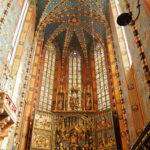Medieval Architecture:
Romanesque or Gothic?
In the Middle Ages, certain elements of a structure were examples of different design types and styles. There was a number of different architecture styles prevalent in the early Middle Ages, they were divided into the following: Early Christian, Merovingian, Carolingian, and Ottonian.[1] However, medieval architecture proceeded to progress into two major types of design: Romanesque and Gothic. Both of these styles of architecture have their own specific characteristics that set them apart, while they also share similarities. Among others, one of the most important architectural aspects of the Romanesque style was the round arch. Unlike the Romanesque style, the Gothic style focused mainly on the pointed arch. Gothic and Romanesque do not only refer to a type of architecture, but also to styles of art. The Romanesque and Gothic styles were very common from the late eleventh century through to the end of the twelfth century. Both structure styles have significantly contributed to architecture in general, but which one is more defined and elegant?
Although Romanesque architecture dates back to the eleventh and twelfth centuries, the name ‘Romanesque’ actually only originated in the early eighteenth century by linking the architecture found in medieval Europe to Roman Architecture through their many similarities of forms and materials.[2] However, although the architectural structures are similar, it is wrong to assume that the Romanesque style originated in the Roman Empire. One of the most important differences between the Romanesque style and the Gothic style is the focus on horizontal versus the vertical form of architecture. The Romanesque style focused heavily on the horizontal form of structure where the building was less high or tall. The style also focused on what it seemed like were ways to create a smaller feeling atmosphere: “The focus was on an almost claustrophobic massing: thick walls, small windows, heavy, ponderous piers”[3]. The main elements that the Romanesque style was comprised of were generally piers, masonry, rounded arches and barrel vaults. The main reason that the walls were so thick on this type of structure was because the excessive weight and force from the enormous vaults against the supporting columns was so great that it forced the architects to construct numerous large masonry piers to oppose the weight at critical points. Although this technique was very effective it also contributed to the already harsh feel of the structure. The overall darkness and gloominess of these buildings is “[b]ecause barrel vaults must be supported continuously along the sides, [therefore] these structures had few windows”[4]. Another important aspect of the Romanesque style is that it completed the transition phase of wooden roofing to roves made entirely of stone. Since the entire structure was built of stone rather than wood, these buildings were much less susceptible to fire.
The Romanesque style of architecture had many variations depending on the location on the building. In Southern Europe the buildings were very richly decorated and graceful, while the buildings in Northern Europe were more austere and separate.[5] Although it seems there was a heavy emphasis on the unattractive qualities of the Romanesque style, architects were always trying to improve the design of the structure. Geoffrey Webb believes that “Norwich and Peterborough are good examples of another development which becomes apparent in the early years if the twelfth century and increases in importance. This is the desire to reduce the mass of the walls”.[6] As he points out, the architects realize the importance to decrease the excessive wall mass and relieve stress from the supporting columns. Not only will this facilitate construction, but it will also remove much of the building’s oppressive feeling. The Norwich Cathedral used a multiplicity of shafts to break up the large number of piers in an ordinary Romanesque structure. Webb states that there was often a pause in the construction of cathedrals after the shafts had been built. Since churches were commonly constructed from east to west, he believes that this is the reason that the naves in the west were often more rich and luxurious than the eastern parts of the building.
There are a number of important structures that really define the Romanesque style. Geoffrey Webb outlines the ones he feels are the most important. One of his examples, the Kelso Abbey, had a very unique two-storey nave and tower. The building was constructed in 1211 and interestingly enough has very short north, south and western arms. This, combined with the great height of the arms creates an effect of space. This is unique because most Romanesque style structures are forced to seem as though their interior space is very limited by the size of the walls and numerous piers. Webb feels that “Kelso was the most splendid Romanesque building in Scotland”.[7]
Webb also reveals strong feelings towards the Durham Cathedral. He actually believes that “[t]he historical importance of the vaults of Durham has perhaps tended to divert attention from other qualities of the building which are hardly less remarkable”[8]. He states that the most remarkable aspect of the cathedral is its eastern limb. The limb is very long, comprised of four full bays and a narrower bay before the main apse. The eastern limb’s internal elevations consist of the main arcades that are spaced on an alternating system, and tribunes that are about half their height. However, the most striking attribute is the decorative system of these elevations.[9]
Similar to the Romanesque style, Gothic architecture didn’t always go by the name ‘Gothic. When the style originated in the early twelfth century it was known as “the French Style”. The term Gothic was only adapted during the Reformation era and was actually meant to be a stylistic insult. Also, as opposed to the Romanesque style, the Gothic style’s main characteristics include the pointed arch, the ribbed vault and the flying buttress. In the fifteen century, Gothic architecture was succeeded by Renaissance architecture beginning in Florence. However, in the mid-eighteenth century, the revival of the Gothic style began to take place in England. It spread through Europe in the nineteenth century, and continued through the twentieth century, being used mainly for religious and educational structures such as universities.[10]
Unlike the Romanesque style which was essentially built from existing ideas, the Gothic style was very insightful and innovative. The style developed elements that allowed for a much greater and more dynamic interior space. These structures were very elegant, and to most “the soaring lines of the Gothic cathedrals with their brilliantly colored walls of glass and traceries of stone must have felt like heaven”.[11] Another major difference of the Gothic style is the pointed arch. The Gothic cathedral builders developed this new type of arch because they realized the round arch used in the Romanesque buildings could withstand much less force and pressure. The pointed arch kept the lines of force within the structure so that the weight applied to the arch was deflected through it, straight down to the ground.[12] Although this type of arch is created thinner, it provides more stability to the structure. This allowed structures of the Gothic style to be larger, lighter and have a much greater height.
Another important characteristic of the Gothic style is the rib vault. Unlike the Romanesque barrel vaults that forced less openings and windows, the rib vault allowed builders to open enormous holes in the wall without compromising the structure’s stability. The development of the rib vault was vital as it allowed the Gothic architects to place roofs over enormous spaces. With the great success of the rib vault, the buildings became traceries of stone that were filled with stained glass. Finally, the third major attribute that set the Gothic style apart from the Romanesque style was the flying buttress. A Romanesque style structure needed large bulky reinforcements on the piers along the walls. The Gothic architects were able to develop a half arch that connected to the piers to apply resistive force while maintaining the large open space – this development was the flying buttress. It also allowed the buildings to be constructed to heights of over thirty metres, and lightened the exterior look of the structures making them look more fragile than brooding.[13]
There are many buildings that clearly exemplify the elegance of the Gothic style, however “[i]t seems almost artificially appropriate that the building to which the origins of the English Gothic style of the thirteenth century are by general agreement to be traced should be the Metropolitan Cathedral of Christchurch, Canterbury.”[14] There are two very important aspects of this cathedral, and they are “the use of Purbeck marble shafting, and the treatment of the clerestory with all that it implies for the general constructional system of the building”.[15] The use of marble shafting is thought of to have come from the great church in Valenciennes which is now destroyed. The marbles shafting is definitely not a usual characteristic of Gothic architecture of that time, and makes this cathedral quite unique. The cathedral’s elegance, height and remarkable architectural design are clearly shown in Figure 2 (above).
Another remarkable Gothic style structure is the Salisbury Cathedral. Its construction began in 1220 when a site was selected specifically so that the building was “unprejudiced by any earlier work”.[16] The building consists of an elegant Lady Chapel, a central tower and spire, a detached bell-tower to the north-west, a long nave, two pairs of transepts and a returned aisle forming an ambulatory, among many other defining aspects.[17] Webb claims that “[i]t is an architectural conception both internally and externally of a very high order”.[18] The church evolved drastically over time – the central tower and spine were only added in the fourteenth century, and the bell-tower was actually removed in the eighteenth century. Geoffrey Webb praises the picturesque effect that is created in the cathedral where the little hall church interpenetrates the ambulatory. Remarkably, this giant cathedral was built in a mere thirty-eight years.[19]
In essence, both styles of architecture were incredibly innovative and they both improved and developed intensely the style of architecture they preceded. However, in the case of the Gothic style, it preceded the Romanesque style of architecture. The Gothic style managed to further develop and improve upon all aspects of the Romanesque style. Also, unlike the Romanesque architecture, the Gothic style was truly unique and original. The methods of construction of the Gothic style were more practical and maximized the amount of interior space in the building. The Gothic style also allowed many windows and openings in the walls to rid the claustrophobic effect that was produced by the Romanesque style. Gothic architecture proves to be more elegant, and unlike its counterpart, it provides not only a graceful exterior look, but also a sophisticated interior atmosphere.
Works Cited
“Building Design/Architecture: Medieval Architecture – Romanesque and Gothic.” 24 April 2007. Science Encyclopedia. 24 April 2007 .
Dale, Thomas E.A. “Speculum: A Journal of Medieval Studies.” Rievaulx Abbey: Community, Architecture, Memory 1 July 2001: 721-733.
Erlande-Brandenburg, Alain. Cathedrals and Castles: Building in the Middle Ages. New York: Harry N. Abrams, 1995.
“Gothic Architecture.” 25 April 2007. Wikipedia. 25 April 2007 .
“Medieval Architecture.” 24 April 2007. Wikipedia. 24 April 2007 .
“Romanesque Architecture.” 23 April 2007. Wikipedia. 24 April 2007 .
“Salisbury Cathedral.” 24 April 2007. Wikipedia. 25 April 2007 .
Webb, Geoffrey. Architecture in Britain: The Middle Ages. Suffolk: Penguin Books Ltd, 1956.
———————————————————————————————–
[1] “Medieval Architecture.” 24 April 2007. Wikipedia. 24 April 2007 .
[2] “Romanesque Architecture.” 23 April 2007. Wikipedia. 24 April 2007 .
[3] “Building Design/Architecture: Medieval Architecture – Romanesque and Gothic.” 24 April 2007. Science Encyclopedia. 24 April 2007 .
[4] Webb, Geoffrey. Architecture in Britain: The Middle Ages. (Suffolk: Penguin Books Ltd, 1956) 40.
[5] Webb, 57
[6] Webb, 18
[7] Webb, 53
[8] Webb, 36
[9] Webb, 37
[10] “Gothic Architecture.” 25 April 2007. Wikipedia. 25 April 2007 .
[11] Webb, 27
[12] Webb, 21
[13] Webb, 77
[14] Webb, 72
[15] Webb, 73
[16] Webb, 96
[17] Webb, 96-97
[18] Webb, 97
[19] “Salisbury Cathedral.” 24 April 2007. Wikipedia. 25 April 2007 .





